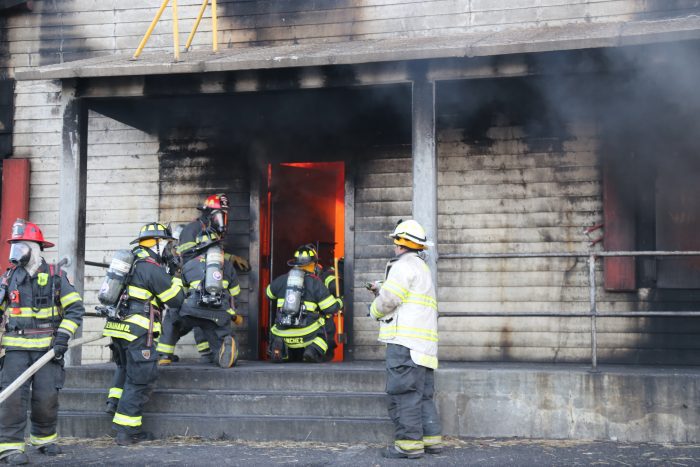By Samantha Rutt
In his inaugural State of the County Address, Suffolk County Executive Ed Romaine (R) outlined a comprehensive four-year plan to revitalize and fortify Suffolk County, emphasizing key priorities such as fiscal responsibility, public safety, infrastructure enhancement and social services reform.
“I am extremely hopeful about the future of this county and there are 18 reasons for that and they all sit around me,” the executive said of his Legislature. “I have watched this Legislature for many years. I was part of this Legislature for many years and I am so impressed with the dedication and commitment of these people,” Romaine said as he stood before the podium.
Addressing an audience May 7 at the William H. Rogers Building in Hauppauge, Romaine outlined his administration’s achievements within its first 100 days while charting a course for the county’s future.
“Let me start off by saying that the state of the county is good — but it can be improved,” Romaine said. “I am going to be working with the 18 people behind me, men and women of goodwill. Men and women of intellect. Men and women to lead this county forward, because I believe our best days are ahead.”
Fiscal strength and accountability
Romaine heralded significant strides in Suffolk County’s financial standing, citing a notable upgrade in the county’s credit rating by S&P Global Ratings.
“One thing I’ve learned over a long life is all issues of government are issues of money,” he emphasized. “Right now our general obligation bonds are rated ‘AA-’. I am happy to say that we got our first upgrade this quarter and we are now ‘A+’.”
With an upgraded rating and a stable outlook, the county seeks fiscal stability and enhanced access to capital markets.
Additionally, Romaine announced initiatives to ensure budgeting practices, including a commitment to adhere to the state-mandated 2% property tax cap and the establishment of a centralized grants office to maximize state and federal funding opportunities.
“New York State has a 2% tax cap, inflation is running a lot higher than 2%,” Romaine explained. “I will submit a budget this September for next year that will not exceed the 2% property tax cap. We cannot afford to do that.”
Investment in public safety
Recognizing the importance of public safety, Romaine announced key appointments within the Suffolk County Police Department and outlined plans to expand law enforcement capabilities.
“Public safety is a concern — we have new leadership in our department,” Romaine said. “As I promised, I’ve hired more detectives, and we have more cops on the street. It’s important because two things that I’ve heard from the voters and residents of Suffolk County is we need the county to be safe and we need it to be affordable.”
Investments in new personnel, equipment and technologies aim to uplift public safety efforts and address emerging challenges. Notably, Romaine emphasized the significance of fair and efficient operations within the Traffic and Parking Violations Agency, a growing concern among residents across the county.
Infrastructure revitalization
Romaine touched on the imperative to modernize and maintain county facilities, highlighting initiatives to renovate and upgrade critical infrastructure. With a focus on improving constituent affairs and enhancing employee morale, the administration plans to address long-standing deficiencies in county facilities, including the Suffolk County Police headquarters and the Medical Examiner’s Office building.
Additionally, plans to reacquire the former John J. Foley nursing home property in Yaphank signals a strategic approach to meet evolving community needs while realizing significant cost savings.
Cybersecurity preparedness
Reflecting on the cyberattack of 2022 and acknowledging the enduring threat posed by cyberattacks, Romaine outlined measures to reinforce the county’s cybersecurity infrastructure. Through comprehensive audits, strategic hiring and resource allocation, the administration shifts its aim to mitigate vulnerabilities and safeguard sensitive data.
Social services reform and environmental preservation
“Now I come to the Department of Social Services, a department that needs a little bit of attention,” Romaine shared. “When I came into office and I read the Newsday article that Suffolk County was one of the worst in the state at processing SNAP [Supplemental Nutrition Assistance Program] applications and that we were way behind in processing social service applications … that is going to change. We are going to put staffing in, we are going to be on top of things.”
Additionally, Romaine reaffirmed the county’s commitment to environmental preservation — just like preservation was a staple of Romaine’s time as Brookhaven Town supervisor — citing investments in farmland preservation and open-space conservation as critical components of sustainable development. The county executive recently appropriated $15 million to preserve farmland across the county. Since taking office, nearly 100 acres of farmland and open space throughout the county has been preserved with additional acquisitions planned later in the year.
Looking ahead
“I believe working together, investing in our infrastructure and rebuilding what is needed in this county as our best days are ahead,” the county executive remarked.
In concluding his address, Romaine articulated a vision of optimism and collaboration, emphasizing the collective efforts needed to propel Suffolk County forward. With a dedicated team and a commitment to transparency and accountability, he expressed confidence in the county’s ability to overcome challenges and realize its full potential.
“Let’s step up to the plate, we have a lot of challenges ahead,” Romaine concluded.






















